7 Types Of Wrens In Ohio (ID Guide With Pictures)
Ever curious about the wrens in Ohio? These small, lively birds make the Buckeye State their home. With seven different wren species, Ohio is a great place for bird lovers. From the common House Wren to the rare Sedge Wren, each one adds to Ohio’s bird diversity.
What do these tiny birds have to offer? Let’s dive into our guide to Ohio’s 7 wren species. We’ll share beautiful photos and tips to help you identify them.
Introduction to Wrens In Ohio
Ohio is famous for its birdwatching, hosting the “Biggest Week in American Birding.” It’s known as the “Warbler Capital of the World.” But Ohio’s bird life is more than just colorful migrants. The state is home to about 450 bird species, including seven types of wrens.
Overview of Wren Species Found in Ohio
The seven wren species in Ohio are:
- Carolina Wren
- Winter Wren
- Marsh Wren
- House Wren
- Sedge Wren
- Rock Wren
- Bewick’s Wren
Learning about these small but interesting birds can make birdwatching in Ohio more rewarding. Knowing how to spot these when species help birdwatchers enjoy all that Ohio has to offer.
Importance of Identifying Wrens
Wrens are intriguing birds that challenge and reward birdwatchers. They are small, hard to spot, and look similar, making them fun to identify. Getting good at recognizing these birds can make you appreciate the Ohio bird list more. It also helps protect these important birds.
“Wrens are the jewels of the bird world – tiny, feisty, and endlessly fascinating.”
1. Carolina Wren
- Scientific name – Thryothorus ludovicianus
- Lifespan – 6 years (average),
- Weight – 0.6 to 0.8 oz
- Wingspan – 11 to 11.4 in
- Status – Least concern
The Carolina Wren is a lively bird found in many parts of Ohio. It’s small and chunky, with reddish-brown feathers on top and a buffy underside. It also has a white throat and eyebrow. Its dark bill and wing and tail bars make it stand out.
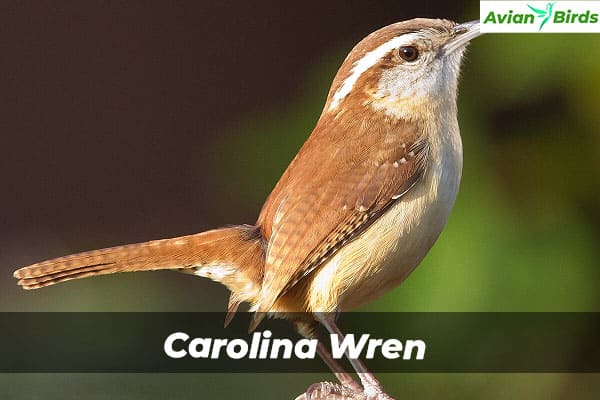
Physical Characteristics
This bird is a bit bigger than a sparrow but smaller than a House Wren. It has a long tail and a rounded body, looking playful and full of energy. It’s known for its loud “teakettle-teakettle” or “germany-germany” calls in the woods.
Nesting
Carolina Wrens build their nests in many places, like tree cavities, stumps, and under overhangs. They also use human-made items like mailboxes and flowerpots in cities and suburbs. Their nests are made of sticks, leaves, and moss. They have two or three broods a year, from March to July.
Diet
These birds eat mostly insects like spiders, crickets, and beetles. They also eat small snakes, frogs, and lizards, as well as fruit and seeds. They search for food by hopping and jumping in dense plants, looking in crevices and on bark.
Where to Find Carolina Wrens in Ohio
You can find Carolina Wrens in places like cypress swamps, woodlands, and overgrown fields. They also like cities and suburbs, visiting feeders, and nesting in buildings. Good places to see them in Ohio include the Cleveland Lakefront Nature Preserve and the Magee Marsh Wildlife Area.
Since the 19th century, Carolina Wrens have moved north through the Great Lakes and New England. They were once rare in northern Ohio but are now common in every county. However, they can be affected by harsh winters, which can reduce their numbers.
| Habitat | Diet | Nesting |
|---|---|---|
| Lowland cypress swamps, bottomland woodlands, brushy thickets, ravines, overgrown farmland, urban and suburban areas | Spiders, crickets, caterpillars, cockroaches, grasshoppers, beetles, moths, small snakes, frogs, lizards, fruit, seeds | Nest in cavities, including trees, stumps, overhangs, and human-made structures; typically raise 2-3 broods per year |
2. Winter Wren
- Scientific name – Troglodytes hiemalis
- Lifespan – 2 years (average)
- Size – 3.1 to 4.7 in
- Weight – 0.3 to 0.4 oz
- Wingspan – 4.7 to 6.3 in
- Status – Least concern
The Winter Wren is a delightful little bird that calls Ohio home. It has brown plumage with a unique barring on its tail, wings, and belly. It also sports a tan crown, eyebrow, throat, and belly. Its bubbly song is a joy to hear, lasting five to ten seconds.
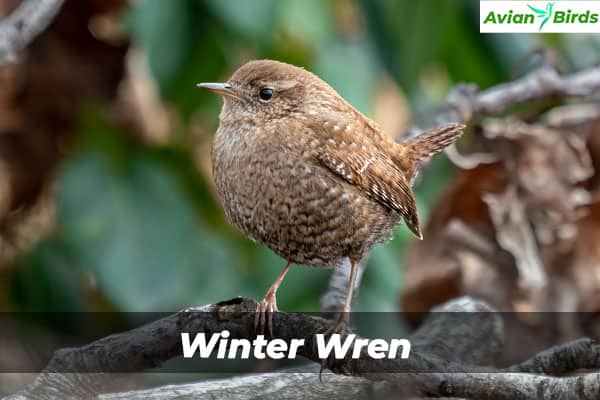
Nesting Behavior
Winter Wrens build their nests in cavities. They prefer spots under creek banks, in tree roots, decaying logs, dead trees, or hanging moss near streams. The nests are made of plant materials like bark, moss, and twigs, often used by various wrens found in Ohio. twigs, grass, and rootlets. They’re lined with feathers and animal hair.
Food Sources
These wrens eat a mix of insects and berries. They enjoy ants, beetles, flies, caterpillars, and mites, as well as spiders, millipedes, and berries. They forage in leaf litter and crevices of forests and in backyards and fields with dense vegetation.
In Ohio, Winter Wrens can be seen all year, but most during winter. Birdwatchers might find them at places like the Cleveland Lakefront Nature Preserve, Killdeer Plains Wildlife Area, Metzger Marsh Wildlife Area, Sheldon Marsh State Nature Preserve, and Headlands Beach State Park.
3. Marsh Wren
- Scientific name – Cistothorus palustris
- Lifespan – Unknown
- Size – 3.9 to 5.5 in
- Weight – 0.3 to 0.5 oz
- Wingspan – 5.5 to 7 in
- Status – Least concern
The Marsh Wren is a unique bird in Ohio, known for its special looks and behaviors. It’s a small bird with a short tail and a thin bill. It has a rusty-brown back with black-and-white stripes. Its belly is whitish, and it has a noticeable eyebrow stripe that aids in wren identification. pale eyebrow and shoulder without stripes.

Distinguishing Traits
This bird makes a buzzing sound and gurgles, helping it stand out in the marsh. It’s smaller than a House Wren but bigger than a Song Sparrow. Finding it among the tall grass and cattails is a fun challenge for bird lovers.
Nesting
Marsh Wrens build dome-shaped nests with a special design. They use grass, sedge, and cattail to make them. These nests are hidden in thick plants, keeping the birds safe. The female lays three to ten eggs, which she takes care of by herself.
Feeding Habits
Marsh Wrens eat insects like damselflies and mosquitoes, and they also enjoy spiders. They move quickly in the marsh, using plants to catch their food.
Habitat Preferences
These birds like living in salt marshes with cordgrass and in wetlands with many plants. In the winter, they might be seen in thickets near canals and salt marshes. In Ohio, you can find them at places like the Fernald Preserve and the Cleveland Lakefront Nature Preserve.
| Physiographic Region | Percentage of Blocks with Confirmed Breeding | Percentage of Blocks with Probable Breeding | Percentage of Blocks with Possible Breeding |
|---|---|---|---|
| Lake Plain | – | – | – |
| Till Plain | – | – | – |
| Ill. Till Plain | 47.1% | – | – |
| Glaciated Plateau | 11.4% | 5.9% | – |
| Unglaciated Plateau | – | – | 14.7% |
The Atlas Project shows where Marsh Wrens breed in Ohio. The Ill. Till Plain has the most breeding activity at 47.1%. The Glaciated Plateau also has breeding, but less than the Till Plain. The Unglaciated Plateau has a lot of possible breeding spots. The Lake Plain and Till Plain don’t have much data on Marsh Wren breeding.
4. House Wren
- Scientific name – Troglodytes aedon
- Lifespan – 9 years (maximum recorded)
- Size – 4.3 to 5.1 in
- Weight – 0.3 to 0.4 oz
- Wingspan – 5.9 to 6.5 in
- Status – Least concern
The House Wren is a small, lively bird found in many parts of Ohio. They stand out with their brown feathers, wing and tail bars, and whitish throat. Their finely barred underside and indistinct eyebrows make them easy to spot.
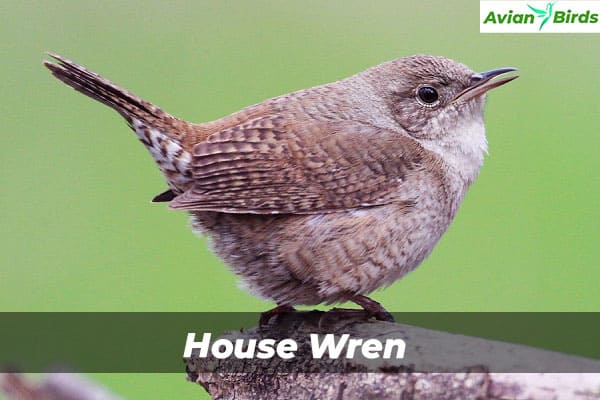
Physical Description
House Wrens are known for their unique songs filled with churrs and scolds. They have a long, curved beak and a short tail. Their brown feathers have bars on the wings and tail. Their throat is whitish, and their underside is pale with fine bars.
Nesting
In Ohio, House Wrens nest in natural spots, woodpecker holes, or nest boxes. They build their nests with sticks and twigs, making a cup shape. The nest’s inside is lined with grasses, snakeskin, feathers, and other materials.
Diet Composition
House Wrens eat mostly insects and spiders. They hunt for flies, beetles, and other insects. Sometimes, they eat snail shells too.
| Nesting Habitat | Nest Materials | Breeding Behavior |
|---|---|---|
| Natural cavities, woodpecker holes, nest boxes | Sticks, twigs, grasses, snakeskin, feathers, animal hair, string, spider egg sacs, plastic | House Wrens in Ohio usually raise two broods each summer |
House Wrens live in many places in Ohio, like forests and swamps. They also do well in cities and suburbs, in places like backyards and buildings.
5. Sedge Wren
- Scientific name – Cistothorus stellaris
- Lifespan – 5 years (average)
- Size – 3.9 to 4.7 in
- Weight – 0.3 to 0.4 oz
- Wingspan – 4.7 to 5.5 in
- Status – Least concern
The Sedge Wren is small with a short tail and a curved bill. It has brown upper parts with heavy streaking and banded wings and tail. Its belly and sides are whitish with a peach color. This wren makes high-pitched notes and trills.
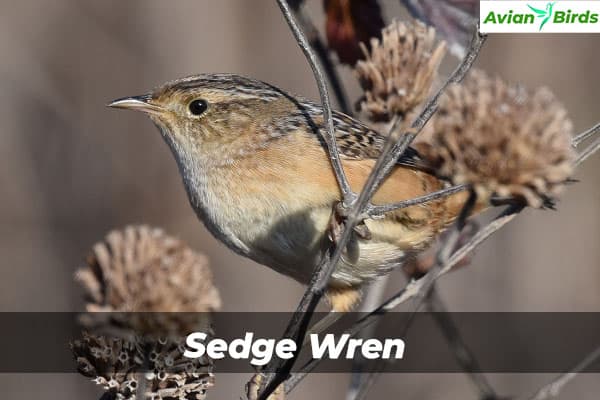
They build spherical nests with a side hole in thick vegetation or on the ground. They lay three to eight white eggs. They eat insects and spiders, like weevils and ants, and some seeds. You can find them in hayfields and marshes during the summer and migration at places like the Cleveland Lakefront Nature Preserve.
6. Rock Wren
- Scientific name – Salpinctes obsoletus
- Lifespan – Unknown
- Size – 4.9 to 5.9 in
- Weight – 0.5 to 0.6 oz
- Wingspan – 8.7 to 9.4 in
- Status – Least concern
The Rock Wren is medium-sized with a long, thin bill and a long tail. Its upper parts are light brown, and its belly is whitish with light streaks. The back, tail, and wings are speckled. They make a varied series of phrases in their song. They nest in cavities between or within rocks on the ground. Rock Wrens eat insects like leafhoppers and ants, some plant material, and spiders. They like dry, rocky habitats with little vegetation, from low deserts to mountain peaks.

Best Birding Locations for Wrens in Ohio
Ohio is a top spot for bird lovers wanting to see different wren species. You can find these birds in wetlands, forests, and even in cities. There are many protected areas and great places to watch wrens in Ohio. Some top spots include:
- Killdeer Plains Wildlife Area
- Metzger Marsh Wildlife Area
- Magee Marsh Wildlife Area
- Sheldon Marsh State Nature Preserve
- Headlands Beach State Park
Other great places for wren watching in Ohio are:
- Oak Openings Preserve Metropark
- Buck Creek State Park
- Cleveland Lakefront Nature Preserve
- Green Lawn Cemetery and Arboretum
- Edge of Appalachian Nature Preserve
- Fernald Preserve
- Lake Erie Birding Trail
These spots have a variety of habitats, perfect for seeing Ohio’s seven wren species. Whether you’re in wetlands, forests, or city parks, you’ll have many chances to see these birds. You can learn about their unique behaviors and features.
| Birding Location | Habitat Highlights | Key Wren Species |
|---|---|---|
| Magee Marsh Wildlife Area | Largest uninterrupted area of coastal wetlands habitats in Ohio | Marsh Wren, Carolina Wren |
| Howard Marsh Metropark | Nearly 1,000 acres, premier birding location in Northwest Ohio, attracting many wrens found in Ohio. | Marsh Wren, House Wren |
| Cedar Meadow Preserve | 62-acre preserve on Catawba Island, a peninsula jutting into Lake Erie | House Wren, Carolina Wren |
| Erie Marsh Preserve | One of the largest coastal wetlands on Lake Erie | Marsh Wren, Sedge Wren |
| Cedar Creek Preserve | Mix of wet woods and grasslands on 42-acre area | House Wren, Carolina Wren |
These top birding spots in Ohio are perfect for seeing many wren species. They are great for both experienced birdwatchers and beginners. These places offer a fun and rewarding experience.
Check Our Previous Articles:
7. Bewick’s Wren
- Scientific name – Thryomanes bewickii
- Lifespan – 8 years (maximum recorded)
- Size (average) – 5 in
- Weight – 0.3 to 0.4 oz
- Wingspan – 7 in (18 cm)
- Status – Least concern
The Bewick’s Wren is a medium-sized bird with a long tail and a pointy, curved beak. Its back is brown, its tail has many bars, and it has a noticeable white stripe above its eye. The underside is light gray, and the throat is whitish. The songs of Bewick’s Wrens can sound different depending on where they live, with each bird having its own mix of notes, buzzes, and trills.
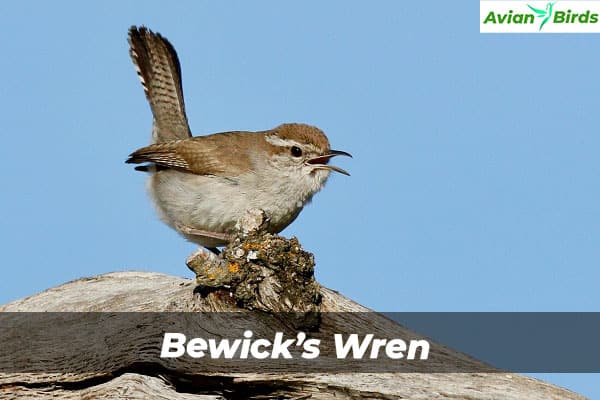
Nesting
Bewick’s Wrens usually build their nests in small holes, on ledges, in nest boxes, in piles of brush, and in old buildings. The nests are cup-shaped and made from grasses, sticks, moss, leaves, and other plant materials. Inside, they line the nest with soft things like wool, feathers, hair, and even snakeskin. The female lays between three and eight eggs, which are white with purplish or reddish-brown spots. These eggs hatch after about 14 to 16 days, and the baby birds stay in the nest for another 14 to 16 days before they fly out.
Food
Bewick’s Wrens eat small insects and other tiny creatures. They often hunt for wasps, bees, moths, butterflies, grasshoppers, beetles, crickets, spiders, and flies. Sometimes, they also eat fruits and seeds.
Conservation
Bewick’s Wrens are still fairly common in their range, with a stable population estimated at around 7.9 million breeding birds. However, their numbers started dropping in the early 1900s, and they disappeared from the Midwest and the eastern mountains. Nowadays, they are not found east of the Mississippi River, and their range in the west has also shrunk.
Final Thoughts
Ohio is home to seven types of wrens, each with its own look, behavior, and favorite places to live. From the reddish-brown Carolina Wren to the tiny Winter Wren and the hard-to-spot Marsh Wren, these small birds are key to Ohio’s ecosystems. Knowing about each wren’s unique traits and needs helps bird lovers enjoy Ohio’s diverse birdlife more.
Keeping wren populations healthy means protecting their homes, planting more trees, and helping them in our backyards. This way, these cute birds can keep living in Ohio’s different places for many years. Whether you’re an expert birder or just like watching birds, learning about Ohio’s wrens is interesting. It shows us how important it is to protect our bird friends.
Let’s keep exploring and valuing Ohio’s wrens and other birds. By working together to save and fix their homes, we can make sure these small but amazing birds and all of Ohio’s birds stay around for a long time.







